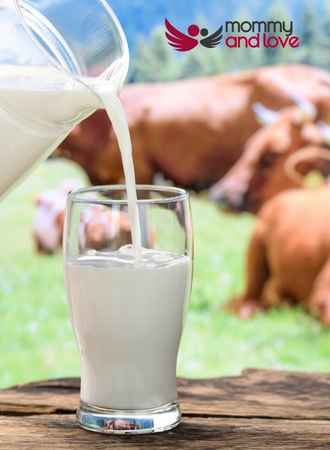Do you ever wonder if the foods you eat are causing your baby’s diaper rash?
It can be difficult to determine what is causing the problem, especially since there are so many potential culprits.
We explore the link between whole milk and diaper rash. We will also provide some tips on how to prevent and treat this common ailment.
There is a lot of debate over whether or not whole milk can cause diaper rash. Some people believe that it is the fat in the milk that causes the rash, while others think that it is lactose.
Affiliate Disclaimer: As an Affiliate, we earn from qualifying purchases.
Milk Diaper Rash – What You Need To Know

Diaper rash appears as bright red, irritated skin on a baby’s bottom.
Most parents blame it on environmental factors including sensitivity to colours or fragrances, infrequent diaper changes, and chafing.
But did you know that itching and inflammation might be caused by milk in your baby’s diet?
Unfortunately, whole milk diaper rash is something that every mother should be aware of.
If you give your infant whole milk for the first time and he develops a horrible diaper rash, he most likely has a food sensitivity.
That is why you must use caution when introducing new foods or switching from formula or breastmilk to cow’s milk.
What’s the difference between whole milk and formula milk?

Formula milk is a cow’s milk-based product that has been modified to better suit the nutritional needs of infants.
It contains water, skimmed milk powder, maltodextrin, vegetable oils, calcium carbonate, potassium chloride, sodium citrate, choline chloride, taurine, L- carnitine, inositol, and ferrous sulfate.
Purified milk protein, lactose, and vegetable oils are included in cow’s milk formula. It is simple to digest and can be used to complement or replace breastmilk when feeding newborns.
On the other hand, whole milk is just that – milk from a cow that has not been skimmed or modified in any way.
It contains all of the natural fat and cholesterol, as well as lactose (a sugar) and protein.
Even if you had cow’s milk formula you might still encounter issues such as milk intolerance or a cow’s milk allergy when you switch over to whole milk.
This is because the proteins in cow’s milk are different from those found in formula milk.
Milk intolerance
If your baby has a sensitivity to whole milk, the best way to avoid a diaper rash is to eliminate it from his diet. This means that you will need to switch him to a milk alternative.
Cow’s milk allergy

A cow’s milk allergy is a more serious condition that requires medical attention. It occurs when the body mistakes one of the proteins in cow’s milk for something it shouldn’t, such as a virus or bacteria.
As a result, the immune system goes into overdrive and produces IgE antibodies.
These antibodies cause the release of histamine, which leads to inflammation and all sorts of unpleasant symptoms such as vomiting, diarrhea, and a rash.
If you think your baby might have a cow’s milk allergy, it is important to see a doctor for diagnosis. The only way to treat this condition is to avoid cow’s milk altogether.
This might mean switching to a soy-based formula or giving your baby breastmilk exclusively.
Lactose intolerance

Lactose intolerance is a condition that affects adults, not babies. It occurs when the body doesn’t produce enough of the enzyme lactase, which breaks down lactose into glucose and galactose.
These two molecules are then absorbed into the bloodstream where they provide energy for the body.
Lactose intolerance is uncommon in babies and usually appears after the age of three in children who were born full-term.
Lactase is present in the intestines of all newborns. The lactase enzyme declines as people age.
Can you prevent milk-induced diaper rash?

There is no surefire way to prevent milk-induced diaper rash, but there are some things that you can do to reduce the chances of it happening:
• Wait until your baby is at least six months old before introducing whole milk. This will give his digestive system time to mature. Read our guide to transitioning to milk from formula.
• Start with a small amount of milk and slowly increase the amount over time. This will help your baby get used to the new food and reduce the chances of a reaction.
• If your baby does develop a rash, stop giving him regular milk and switch to a milk alternative.
• Make sure that you change your baby’s diaper often, especially if he is drinking lots of milk.
• Use a barrier cream or ointment to protect his skin from irritation.
If your baby does develop a diaper rash, don’t panic! Most cases can be treated at home with some simple measures. However, if the rash does not improve or if your baby is in a great deal of pain, it is important to see a doctor.
We recommend using natural alternatives to diaper rash cream to treat diaper rash such as using coconut oil, zinc oxide or shea butter, lotion made from breastmilk (if available), the egg white diaper rash remedy or even using something natural like a cornstarch bath to ease diaper rash.
Milk Alternatives

Thankfully these days there is a wide range of whole milk alternatives for people with a milk allergy. If you still want your child to drink milk but they have a milk tolerance or a dairy sensitivity then you can check this wide range of milk alternatives.
However, you need to ensure that they are getting enough fat into their diet, though normally once you introduce solid foods this is not an issue.
If they are lactose intolerant then you will need to remove all cows milk products like cheese, dairy products, yogurt etc.
When introducing any new milk or food, always give it a few weeks to see if they have loose stools or an allergic reaction to the new food.
Soy Milk

Soy milk is a good alternative for babies with cow’s milk allergies. It is high in protein and contains all the essential amino acids needed for growth and development.
Soy milk also has vitamins B12, D, and E, as well as minerals such as calcium, magnesium, and zinc.
There are two types of soy milk: processed and unprocessed. Processed soy milk is made from boiled soybeans that have been ground into a thick liquid.
Unprocessed soy milk is made from whole, dried soybeans that have been soaked in water overnight.
Many people find processed soy milk more palatable than unprocessed soy milk. It has a milder flavor and a thicker texture. Unprocessed soy milk is thinner and has a stronger flavor.
Soy milk can be used in recipes as a substitute for cow’s milk. It is also available in cartons, just like cow’s milk.
You can also else get soy formula if you feel your formula is causing issues, but also read our guide to babies refusing formula bottles.
Almond Milk
Almond milk is another good alternative to cow’s milk. It is made from ground almonds and water and is high in calcium and vitamin E.
It is available in both regular and unsweetened varieties and can be found at most supermarkets.
Rice Milk
Rice milk is a good choice for people who are allergic to soy or almonds. It is made from boiled rice and water and is high in carbohydrates and B vitamins.
It is available in both regular and unsweetened varieties and can be found at most supermarkets.
Hemp Milk
Hemp milk is made from hemp seeds and water and is a good source of omega fatty acids, vitamin d, protein and minerals.
It is available in both regular and unsweetened varieties, but it can be harder to find than other types of milk.
Skim Milk
Skim milk is a low-fat alternative to whole milk. It is made from skimmed milk (milk that has had the cream removed) and water.
It is available in both regular and unsweetened varieties and can be found at most supermarkets. Ensure your baby is getting fat content from other sources.
Goat Milk
Goat milk is a good alternative for people who are allergic to cow’s milk. It is high in calcium and vitamin A and has a slightly sweet flavor.
Goat milk is available in both regular and unsweetened varieties and can be found at most health food stores.
Coconut Milk
Coconut milk is made from the flesh of coconuts and water. It is high in saturated fat and is not a good choice for people who are trying to lose weight or lower their cholesterol levels.
However, it is a good source of vitamins C and E, and minerals such as magnesium and potassium. Coconut milk is available in both regular and unsweetened varieties and can be found at most health food stores.
There are also a number of milk alternatives that can be made at home, such as oat milk, hazelnut milk and cashew milk. If you’re feeling adventurous, why not give them a try?
Is it the Milk Causing the Diaper Rash?
Before you blame the milk or milk intolerance for causing the diaper rash you need to rule out any other food allergy or any other type of yeast infection which could be causing diaper rashes.
If you are using cloth diapers, do they need to be stripped? Is a new washing powder causing the issue? Have you changed the brand of disposable diapers recently?
Did you have any diaper rash when your baby was on breast milk or just formula?
Is this the worst diaper rash they have had or are there common symptoms from before? Is it down to the baby’s growth or teething?
If you have answered yes to any of the above then your p rule out other causes before you just to lactose intolerance or milk intolerance.
Conclusion
Whether your baby has a cow’s milk allergy or sensitivity, there are plenty of whole milk alternatives available to choose from.
We recommend trying a few different types to see which one your baby likes best. If your baby does develop a milk-induced diaper rash, don’t worry – most cases can be treated at home.










